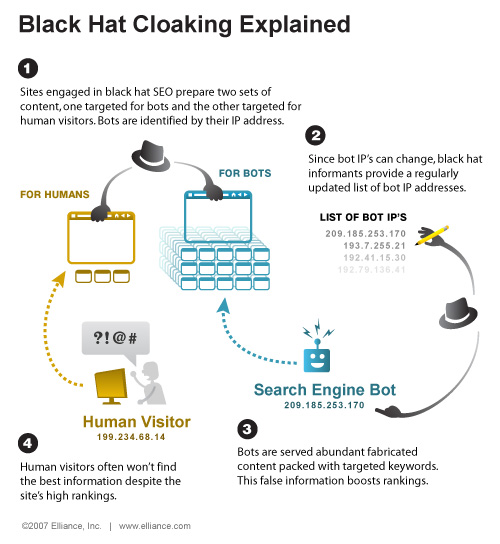Black-hat SEO tactics just don’t cut it anymore.
Using old black-hat strategies will not just guarantee that you get heavily penalized; you will also be wasting your precious time and resources.
But just in case some online marketers started out post Panda and Penguin and are wondering, what were these ancient black-hat SEO tricks?
It might be good to remind not just newbie Internet marketers, but everyone else, that the following can spell doom for your business.
Table of Contents
Buying Backlinks
As the name implies, link buying helps you rank your site by paying for links.
A significant part of SEO is establishing link popularity to measure the credibility and authority of the site. By linking from authoritative and highly credible sites, newer ones would see increases in authority and search engine rankings.
Because linking from big sites such as Mashable, Inc.com, WSJ.com, etc., could be very hard to accomplish, enterprising individuals devised a way to offer smaller sites a fighting chance by getting linked from tons of sites to boost rankings and traffic.
Major search engines tried to weed out this kind of cheating even before Google Penguin waddled on the scene. But because Google and other search engines had been lenient in the past, a lot of people got caught engaging in this unethical online practice.
If you ever come across a site that offers link-building services, be sure to investigate what sort of link building they do.
Cloaking
When a webmaster serves different content to a visitor from what the search engines see, that is known as cloaking. It should be obvious to anyone that this is downright deceitful.
How does someone do this? Simple.
The webmaster can direct his web server to provide information based on who requests it. Different information is provided to requests that come from web browsers as opposed to those from search engines.

Pretty neat . . . but extremely dangerous.
The intent of cloaking is to hide the real purpose of a page from the search engines, obviously. The page could actually turn out to be a spammy sales site that offers very little value after pretending to be a text-based version for the benefit of search engine spiders. But they discover the truth eventually.
Keyword Stuffing

This is an age-old spam tactic that even the oblivious newbie may fall for. By keyword stuffing, black hatters cram the page with keywords to make it look very relevant to the eyes of the search engine spiders.
The goal of keyword stuffing is to place as many exact-match keywords as possible throughout the content to make it look very relevant to search. Search engines are becoming smarter by transitioning into latent semantic indexing (LSI), which is making keyword stuffing largely irrelevant.
Plus, to the discriminating reader, keyword-stuffed pages are hard to read and often just annoying.
While keyword-optimizing a content is still crucial, webmasters and SEOs should observe best practices for post Penguin SEO. Above all, remember to write for the reader, not for the search engines, and traffic will flow naturally to your site.
Hiding Text
For the newbie, the only way for search engine spiders to determine what a page is all about is by reading texts.
Got that? The search engine spiders are programmed to read texts, but not to determine visuals. We’re not sure how long it will be before search engines come up with a technology that enables spiders to recognize images. But it’s probably in the works.
At least until recently, it was quite easy to trick the spiders by hiding texts within images. This fooled them into recognizing an image based on the underlying texts.
One of the more common tricks of black hatters was to hide the texts completely from readers by using font colors that matched the page’s theme.
Even if you get away with hidden texts, you won’t get very far. The search engines are becoming more sophisticated about spotting hidden texts. The competition is also becoming more vigilant in watching for dubious content.
Strive always to provide value by producing sincere content that is free from any form of deceit. The search engines, as well as your readers, will love and reward you for it.
Spammy Backlinks
There’s a risk to allowing visitors to create profiles and leave comments on your site. It could become a channel that harbors spam messages and links to offending sites, which in turn raises red flags, and as a result, can hurt your ranking.
Blogging and other activity in social media are crucial to get you and your followers involved in meaningful interactions, but your site’s reputation could take a negative hit if you fail to manage your social community properly.
Encourage your visitors to participate in conversations with you and the rest of the community, but screen every comment religiously. A good way to filter site comments is to approve each of them manually.
Also, it’s wise to make sure your blog commenting section is set to “nofollow” on outbound links.
Keep your site clean by diligently checking links that online comments include to point to other sites. Be sure that none of the links they leave point to “bad neighborhoods.”
Keep in mind that search engines watch for sites that have relationships with these “bad neighborhoods,” because they are keen to keep the Internet free from unwanted and spammy information.
Conclusion
Whether we like it or not, Google still calls the shots. As long as we play by their rules (which are, in most cases, beneficial to everyone online), we should be doing fine.
If you have questions on proper link-building strategies, contact us and we would be delighted to discuss them with you.
Want more information on link building? Head over to our comprehensive guide on link building here: SEO Link Building: The Ultimate Step-by-Step Guide
- Your Law Firm SEO Expert: Choosing a Marketing Partner for Your Law Firm - April 10, 2024
- 7 Most Important Keyword Metrics to Track in SEO - April 2, 2024
- Niche Edits: A Guide for Niche Edits in SEO Link Building - February 5, 2024




